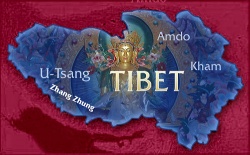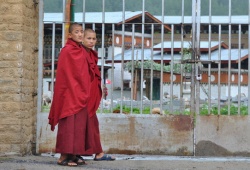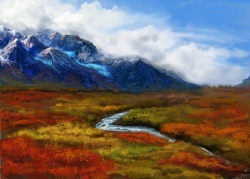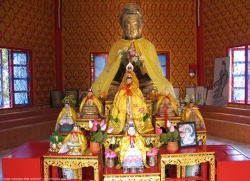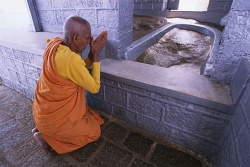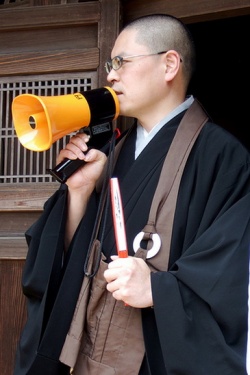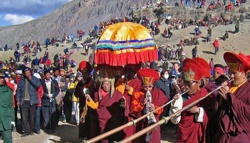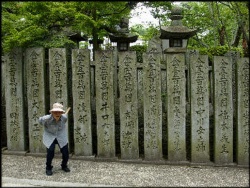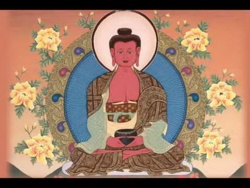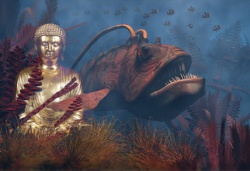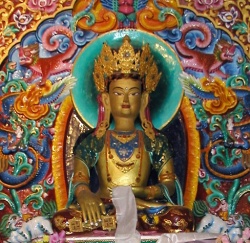About The Bon
There is much written about this indigenous pre-Buddhist culture and religion of Tibet that is speculative.
It is challenging to create a narrative that presents a well-rounded perspective of these ancient peoples, due to several facts, some of these being that the roots of Bon existed as an oral tradition,
that the ancient Bon later developed the spoken and written language of Zhang Zhung that was thought to be extinct or even mythical,
and that the complex influences between Bon and Buddhist cultures have blurred the lines of distinction between these two.
The Bon culture as narrated by the Bon, speak of its roots spanning 18,000 years, and there is growing archeological evidence to substantiate this.
Many references exist in the vast reservoir of Tibetan scriptures but not until the American John Vincent Bellezza began to do extensive research beginning in the early 1990’s did overwhelming evidence of this territory the size of Texas and California combined begin to take shape.
In his book, Tibetan Stones of Time:Exploration of the Ancient Bon Kingdom of Zhang Zhung, Bellezza’s findings date the stone remains to the Iron Age, a time span from the First millennium BC to the period of the first Buddhist Kings of the 7th century AD.
Most recently, the German scholar Bruno Baumann has also traveled to this region to experience first hand evidence of these people within the rock art.
An excerpt from the recent article by Juergen Kremb Buamann’s new book, The Silver Palace of Garuda, The Discovery of Tibet’s Last Secret, reads as follows.“…the remnants of ancient foundations are everywhere, and the remains of ramparts extending several hundred meters line the top of the cliff.
Locals call the mountain “Khardong,” or “In the View of the Palace.”
Baumann is quoted as saying, “this must have been where it all began, the cradle of Tibetan culture, in a bleak, high valley settled by nomads, at least 1,000 kilometers (622 miles) from Lhasa.
The cradle of Tibetan culture doesn’t lie in Lhasa,” says Baumann, as he descends from Mt. Kailash, “but in the distant past of the Zhang Zhung kings.”
Bon has survived continuously as a living tradition especially among the lay people who despite the over whelming odds, have passed on their culture and religious traditions from generation to generation.
As a tribal people profoundly dependent upon their environment, such interconnected awareness permeated every aspect of life.
This profound relationship with nature and the five elements of earth, air, fire, water, and empty space is found amongst the worlds’ indigenous people.
When disturbances occur and afflictions manifest within these complex relationships, a shaman or Bon priest responds by way of ritual to facilitate the healing of physical and environmental as well as spiritual distress by mediating between the unseen forces to restore harmony.
Scholars have also agreed that Tibetan prayer flags originate from the ancient Bon culture. Symbolizing the union and balance of the five elements, prayer flags are a principle way of transmitting prayer, and acknowledging the divine.
Bon History
Much of Bon history can be viewed as paradoxical, due in part to the nature of the narrative being slowly reshaped by the influence of Buddhism appearing in Tibet in the 7th century.
History retold by a Bonpo, as a follower of Bon is called, will speak of lands, by names that have long been forgotten by the modern world.
This veiled mystery is a source of fascination to scholars and student alike presenting the earnest seeker a rich opportunity for future discovery. For example, the Bon as a religion is believed to have originated from the land of Olmo Lungring in Tazik.
Many modern day scholars recognize Tazik as the present day Tajikistan, which is situated northwest of the once thought to be mythical Kingdom of Zhang –Zhang, which is West of Tibet, near Mt Kailish, a holy place for many religions.
As the teachings flourished throughout the ancient empire of Zhang –Zhung they were brought to Central Tibet sometime before 600 A.D. Tibetan Buddhism, distinct from its Indian and other Asian counterparts, arguably owes much of this uniqueness to the influence of Tibetan Bon.
Many native Bon elements are obvious within Tibetan Buddhist rituals, and in turn, the New Bon of today reflects Buddhist influence as well.
There remain many distinctions within these two religions, but both share a common and ultimate commitment to the enlightenment of all sentient beings.
Integral to the religious practice of Bön is a heightened sense of esthetics. Whether it be through the arts, philosophy, theology, mudras, mantras, ritual, dance or astrology,
examining, perceiving and experiencing our intrinsic relationship to nature, and to the natural mind is an ever- evolving unfoldment of revelation and practice whose transforming mere existence into an experience of living with universal wisdom and compassion for all.
Bon Spirituality
Within present day Bon, are three classifications including Old Bon, Yungdrung Bon, and New Bon.
Yungdrung doctrine, or otherwise known as Eternal Bon, is dedicated to perpetuating the teachings of their founder Tonpa Shenrab Miwoche, who occupies a preeminent position in Bon culture similar to that of Sakyamuni in Buddhism.
The teachings and practice of Yungdrung Bon contain the Nine Ways or the Nine Gradual Views of Bon, the Four Portals and Treasure as the Fifth, and the External, Internal and Secret Bon.
Bön, was officially recognized in 1978 by the Dalai Lama as the fifth wisdom school of Tibet.
- Cha Shen Thegpa: the Way of Prediction - Describes the four methods of prediction; astrology, ritual examination of causes, and prophecy
- Nang Shen Thegpa: the Way of the Visual World - explains the psychophysical universe, as relating to the origin and nature of gods and demons living in the world and the methodology of exorcism and the liberation of beings through energetic exchange
- Trul Shen Thegpa: the ppWay of Illusion)]- rites for dispersing adverse powers
- Si Shen Thegpa: the Way of Existence –describes the phases after death and the methods for guiding living beings toward final liberation
- Ge Nyen Thepga: the Way of a virtuous layperson’s path, offers ten principles of practices for well being, and the practice of fasting
- Drang Song Thegpa: the Way of Monkhood - explains the rules of monastic conduct and the first level of tantric practices
- A Kar Thegpa: the Way of Pure A or Primordial Sound – elucidates higher tantric practices and the necessary rituals of visualization as well as the tantric practice of che rim, explaining how to cut the bonds of rebirth, death and the intermediate state
- Ye Shen Thegpa: the Way of Primordiality – expounds upon the essential reasons for having the appropriate master, place and occasion for tantric practice and emphasizes the perfection tantric process dzog rim, and obtaining the illusory body, gyu lu.
- La na me ba: the Unsurpassable Way – details the doctrine, views, meditation and behavior of the Great Perfection, Dzogchen
Yungdrung Bon founder Tonpa Shenrab Miwoche
This is a photograph of the statue of Tonpa Shenrab that is within the Bon Temple at the Menri Monastery in Dolangi, India.
According to Bon texts, Tonpa Shenrab Miwoche was born a prince, married and had children. At the age of 31, he renounced worldly life to teach the Yungdrung Bon doctrine.
During his whole life his efforts to propagate the Bön religion were obstructed by the demon Khyabpa Lagring (Khyab-pa Lag-ring), that fought to destroy or impede Tonpa Shenrab’s work until eventually the demon was converted and became his disciple.
Once while pursuing the demon to recover his stolen horses Tonpa Shenrab arrived in present-day western Tibet.
This was his only visit to Tibet.
On this occasion he imparted some instructions on the performance of rituals, but on the whole he found the people unprepared to receive more teachings.
Before leaving Tibet he prophesied that all his teachings would flourish in Tibet when the time was ripe. Tonpa Shenrab passed away at the age of eighty-two.
Symbology in Yungdrung Bon
Quintessential to the Yungdrung Bon is the symbol of the yungdrung, or swastika.
The swastika in general is found throughout antiquity. The right turning swastika is solar, while the leftward turning swastika is lunar.
Defined within the language of Sanskrit to mean, “so be it” or good fortune, there is no connection to Hitler’s Third Reich swastika and its ascribed meanings.
In the Tibetan Bon language of Zhang Zhung, its meaning is translated as (yung) no beginning, and (drung), no end.
This Bon belief in the left-turning primordial spiral of the universe is why the Bon practitioner circumambulates holy mountains, shrines and turns a prayer wheel, counter-clockwise.
To the Bonpo, holy days and their sacred rituals are based on the lunar calendar.
Bon cosmology speaks of the universe being born from a single egg.
The Bon spiral in all its essence is primordial mother.
Noteworthy is the fact that our earth, moon and solar system spin counter-clockwise, and that scientists theorize the nebula that created our universe also was spinning counter clock-wise and thus generated the spin of our solar system.
The moon not only rotates counter-clockwise around the earth, it does so in the shape of an oval, or egg- shape.
Within the Yungdrung are the five directions of the universe.
The four directions of the symbol are the corners, with the middle as fifth, indicating the structure of all the energies of the universe.
The yungdrung can be found in the right hand of Tonpa Sherab in the form of a scepter, otherwise known as a chagshing.
One Yungdrung symbolizing the outer teachings, the other the inner teachings and the middle representing the teachings of Dzogchen.
Needless to say, it is profoundly intriguing that Tonpa Shenrab introduced Yungdrung Bon 18,000 years ago with a cosmic map that scientists today are only beginning to discover!
Also important to mention is the holy Mt. of Kailash, or “Yungdrung Gutseg”.
The Zhang Zhung translation means, “nine swastikas stacked one above the other”. Correspondingly, are nine stacked below in the underworld.
Mt. Kailash is revered by many traditions within its region and is given many names such as, “the navel of the world”, and notably, the Axis Mundi or literally, the axis of the world.
According to Barbara Walker in her book, The Woman’s Dictionary of Symbols and Sacred Objects, the mystical nature of the human body’s spinal column is referred to as the merudanda “as an inner,
individual echo of the cosmic axis mundi.” Noteworthy is the way the body’s cosmic life force supposedly coils around and up the merudanda in a double spiral, one solar and the other lunar.
One is reminded of the Buddhist pilgrims’ clockwise and Bons’ counterclockwise circumambulation of their holy Mt Kailash.
As well, this reflects the design of the double helix of DNA.
And so it is that the pilgrims’ mystical path is simultaneously generating cosmic life force internally and assisting the world’s cosmic evolution externally, in this dual circumambulating of “the navel of the world”.
